Progressive knowledge loss: A longitudinal case study
Published online by Cambridge University Press: 22 March 2006
Abstract
The evolution of the progressive loss of semantic knowledge of a patient, VZ, with lesions mainly affecting the infero-medial temporal lobes, was followed for two years. At the beginning of the study VZ's performance was mainly characterized by a category-specific deficit for living things and a modality-specific deficit for perceptual attribute knowledge. As time went on, VZ's disorder affected all categories by changing the relationship between category and attribute knowledge. Data show that dissociations may change in the course of progressive cognitive breakdown, depending on both degeneration stage and task demands. VZ's performance is discussed in the light of the most influential theoretical accounts. Methodological suggestions regarding longitudinal studies of degenerative patients are also put forward. (JINS, 2006, 12, 275–284.)
- Type
- NEUROBEHAVIORAL GRAND ROUNDS
- Information
- Journal of the International Neuropsychological Society , Volume 12 , Issue 2 , March 2006 , pp. 275 - 284
- Copyright
- © 2006 The International Neuropsychological Society
INTRODUCTION
Different explanations of selective semantic disorders have widened the theoretical framework on the structure of the conceptual system of human beings. Category-specific deficits affect the knowledge of specific conceptual categories, while sparing the knowledge of other ones. They could, for example, affect the category of living things (i.e., animals, fruits, vegetables, etc.), while sparing the category of nonliving things (i.e., objects in general, tools, vehicles, etc.), or vice versa. The most important distinction within theoretical models is that between the Sensory-functional theory (SFT) (Warrington & McCarthy, 1987; Warrington & Shallice, 1984) and categorical theories, such as Caramazza and Shelton's (1998) Domain-specific one.
Warrington and Shallice (1984) conceived the semantic memory system to be a general-purpose computational device, whereby category-specific effects are the result of specific processing requirements. To distinguish different living things from each other, for example, a perceptual analysis is primarily required, but not a functional one, because living things are not usually handled as tools, or used in some way. To distinguish nonliving things, however, does primarily require an analysis of their use or function, and in this case, it is the detailed perceptual analysis that is less important. Thus, the disruption of perceptual analyses is expected to lead to a selective deficit for the processing of living things, whereas the disruption of functional analyses is not (e.g., Farah & McClelland, 1991). And, conversely, the disruption of functional analyses is expected to lead to a selective deficit for the processing of nonliving things, whereas the disruption of perceptual analyses is not assumed to have as large an effect.
Caramazza and Shelton (1998) regard the semantic system as a collection of distinct cognitive—and perhaps neural—mechanisms for the processing of different categories of things (e.g., animal, plants, and tools). They argue that these mechanisms reflect specific evolutionary adaptations. In contrast to SFT, the Domain-specific theory suggests that damage to one of the domain-specific mechanisms would affect the processing of exemplars of a specific conceptual category, regardless of which features (sensory or functional) are processed. However, the theories that typically address focal lesions, do not seem to account for all available data. The SFT cannot entirely describe the deficits of patients who have trouble dissociating living from nonliving things and show no difference dissociating their perceptual and functional aspects (e.g., Lambon-Ralph et al., 1998a, 1998b; Kolinsky et al., 2002). Moreover, semantic deficits rarely reflect a clear-cut distinction between living and nonliving things. More often, the deficits show fractionations, involving small categories instead (e.g., Hart et al., 1985; Hillis & Caramazza, 1991), such as, a deficit for, say, knowledge of animals that spares knowledge of fruits and vegetables.
Devlin et al. (1998) and Tyler et al. (2000) took a different perspective, and proposed correlational models that assume a unitary semantic memory system. The model by Devlin and colleagues is based on the finding of Gonnerman et al. (1997) that in the early stages of Alzheimer's disease (AD) patients show a category-specific deficit for nonliving things, whereas in later stages this effect reverses, with a greater deficit for living things instead.
The model proposed by Tyler et al. (2000) focuses, on the one hand, on the close interdependency between living and nonliving categories, which is based on a complex relation between two dimensions of features: (a) their nature (i.e., types), being either perceptual or functional; and (b) their distribution across the network being either shared (a feature is common to many exemplars of a semantic category) or distinctive (a feature is typical of a specific exemplar or of very few exemplars). Different combinations of these two dimensions (i.e., perceptual/distinctive; perceptual/shared; functional/distinctive; functional/shared) characterize semantic features. The authors emphasize also the role of task requirements in evaluating a patient's performance. Patients with category-specific deficits may show different levels of impairment of their knowledge of a category, depending on the task that is administered. Importantly, shared knowledge of both perceptual and functional features of living things is relatively spared in cases with mild-to-moderate degeneration, and allows discrimination between categories (e.g., animals vs. tools), but not between exemplars within a category (e.g., tiger vs. zebra). Distinctive-functional knowledge of nonliving things may be impaired in this case, but it can to some extent be circumvented, with the retrieval of knowledge of perceptual features (in this case, shape characteristics). The net result is that both the discrimination between categories (e.g., tools vs. animals) and the discrimination within the category of nonliving things (e.g., pliers vs. scissors) are spared. In the more severe stages of the disease, both functional and perceptual features become progressively unavailable, first affecting knowledge of living things—already more impaired than knowledge of nonliving things—and finally involving also knowledge of nonliving things.
Studies on degenerative disease patients are now providing a new source of data related to the organization of the semantic memory system. A number of reports describe a category-specific deficit for knowledge of living things associated with specific deficits in perceptual knowledge, whereby knowledge of nonliving things was spared or at least still relatively good, consistent with SFT (e.g., Basso et al., 1988; Breedin et al., 1994; Cardebat et al., 1996). In subsequent studies, however, a selective deficit for living things was found without any difference in the knowledge of perceptual and functional attributes (Barbarotto et al., 1995), a result that is more easily explained by the Domain-specific theory of Caramazza and Shelton (1998). Relevant findings are presented by Lambon-Ralph et al. (1998a) who compared two patients with dementia: an AD patient with a category-specific deficit for living things, without any difference between perceptual or functional (or associative) knowledge, and a semantic dementia patient with a slight advantage for living things, and a selective impairment for perceptual rather than functional attributes. The performance of the two patients allowed authors to observe that a selective impairment for features does not necessarily imply a category-specific deficit, in contrast with the SFT hypothesis. Furthermore, in a longitudinal study of a patient with semantic dementia, Tyler and Moss (1998) found that functional knowledge is less vulnerable to deterioration than perceptual information. Noteworthy, a greater loss for nouns than for verbs and actions was also observed, in both a single-case investigation (Silveri et al., 2003), and in a group study (Bak & Hodges, 2003).
Thus, patients with degenerative diseases can provide precious and counterintuitive contributions to the understanding of the semantic memory system that challenge current theories. The great variability among these patients with respect to the quality and quantity of their semantic knowledge impairment, may be due to the peculiar progressive nature of the disease. In fact, various disruptions of the cognitive system may highlight changes happening over time that can even lead to opposite findings in different single-assessment studies. In longitudinal investigations, however, semantic deficits can be tracked with success, and the influence of the patients' global level of cognitive impairment on their performance in semantic tasks can be taken into account.
The present study examines the evolution of semantic disorders in a patient (VZ) over a period of two years. VZ's categorical knowledge for living versus nonliving things interacts with feature knowledge (perceptual vs. functional), in a complex fashion, during the progression of the disease; eventually, the patient shows clear fluent aphasia with empty speech correlated with a severe semantic damage involving all categories, but sparing knowledge of actions.
CASE REPORT
VZ is a 64-year-old housewife, with five years of education, complaining about forgetfulness and name retrieval problems. Magnetic resonance imaging (MRI, see Figure 1) made at the beginning of the study showed white matter lacunar infarcts and patchy periventricular hyperintense lesions, mainly adjacent to the right atrium and to the frontal horns. Severe atrophy involved the right superior, middle and infero-medial temporal gyri, particularly the right hippocampus and parahippocampal gyrus, and the right perisylvian regions. There was also less prominent diffuse atrophy. A second MRI made one year later, during the second assessment, was very similar to the previous one. No other images in the later stages are available.
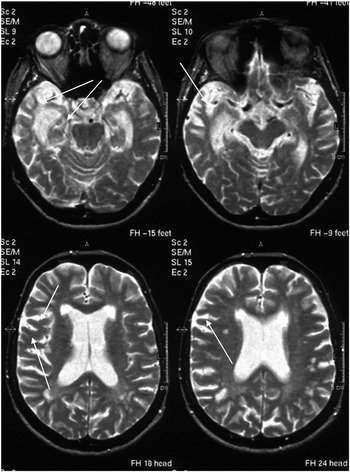
MRI scan of patient VZ, showing severe atrophy involving the right superior, middle and infero-medial temporal gyri, and the right perisylvian regions.
NEUROPSYCHOLOGICAL ASSESSMENTS
In the first of three subsequent assessments, VZ was tested on the MMSE (Mini-Mental State Examination, Folstein et al., 1975), on the MODA battery (Milan Overall Dementia Assessment, Brazzelli et al., 1994), and on a series of neuropsychological tests (Table 1, first assessment). The patient was alert, cooperative, and well-oriented in time and space. The language was fluent, syntactically and semantically correct, and verbal comprehension was perfect (Token test); furthermore, she was flawless in naming actions (15/15 correct). VZ was also tested with the VOSP (Visual Object and Space Perception Battery, Warrington & James, 1991) and the BORB (Birmingham Object Recognition Battery, Riddoch & Humphreys, 1993) batteries. She had intact basic visuo-perceptual and spatial abilities, and accomplished all tasks that did not require access to stored knowledge (BORB Minimal Feature, Foreshortened View and Copy of Drawing). However, when the task required the retrieval of visually stored information (VOSP and BORB Object Decision subtests; VOSP Silhouettes; BORB Drawing from Memory), VZ showed severe impairment. Despite her spared access to knowledge of super-ordinate categories (BORB Item Match), VZ was unable to perform more associative semantic inferences from visually presented stimuli (BORB Association Match). Finally, although she did not show signs of ideomotor apraxia, VZ was defective in an ideational apraxia test (both of these tests were administered only during the first assessment).
VZ's general neuropsychological examination during the first and the second assessments
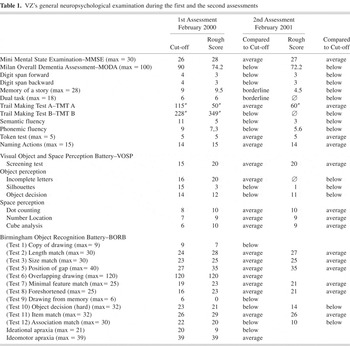
The pattern shown by the patient did not match the criteria for Dementia of Alzheimer type as described in the Diagnostic and Statistical Manual of Mental Disorders, Fourth Edition, which requires a main disturbance in episodic memory plus another cognitive deficit (American Psychiatric Association, 1994). Rather, VZ fulfilled the criteria for semantic dementia, as previously reported by Hodges et al. (1995). The patient also received a neurological examination and laboratory tests to rule out other causes of dementia.
One year later, although VZ's language was still fluent with correct syntax, and she was still well-oriented in time and space (orientation part of the MODA), she failed the MMSE memory test (27/30 correct overall) and showed a slight decline in the neuropsychological part of the MODA battery (Table 1, second assessment). In the remaining tests, VZ showed a substantial decrement, with only a few exceptions (Token Test, TMT-A and Naming actions, 14/15 correct). VZ's basic visuo-perceptual and spatial tasks still appeared broadly intact, except in the VOSP Incomplete Letters subtest (perhaps due to an increasingly widespread impairment in reading). As in the previous assessment, in visual presemantic tasks, and in matching stimuli to stored categorical knowledge, the patient's performance was normal. However, her ability to retrieve stored perceptual knowledge, and to make semantic associations was extremely poor.
VZ underwent a further neuropsychological evaluation, one year after the second examination (third assessment). Her spontaneous language appeared fluent, but meaningless, producing almost exclusively verbs, adverbs, and prepositions without nouns. At this level of degeneration, the neuropsychological evaluation could only be very limited. On the MMSE, VZ obtained a score of 9/30 showing deficits in orientation, object naming, memory, comprehension, and copying of drawings.
MATERIALS AND METHODS
In the experimental investigation, naming abilities and semantic knowledge were assessed to verify whether the disorder was at the level of lexical retrieval, or at a higher level (i.e., in processing semantic information). For this purpose VZ's performance was investigated in two subsequent assessments, one year apart, using the same three tests on both occasions: (1) Picture Naming, (2) Naming on Verbal Definition, and (3) Semantic Judgment. As will become clear later, a third experimental assessment was not possible anymore for the patient two years after the beginning of this study, and only the Picture Naming test was presented to the patient.
Picture Naming
VZ's naming ability was assessed with 60 pictures (see Laiacona et al.'s battery, 1993) divided into 30 living things (10 animals, 10 vegetables, and 10 fruits) and 30 nonliving things (10 tools, 10 vehicles, 10 pieces of furniture).
Naming on Verbal Definition
Since a Picture Naming deficit could also be ascribed to a visual recognition disturbance, the purpose of this task was to elicit names by their verbal definitions. Furthermore, to evaluate the role of attributes in name finding, a verbal definition of 15 living and 15 nonliving items was presented orally, with emphasis on either perceptual or functional attributes. Four different combinations between attribute-type (perceptual/functional) and stimulus-type (living/nonliving) were constructed (Appendix 1): (1) perceptual/living; (2) functional/living; (3) perceptual/nonliving; and (4) functional/nonliving.
Semantic Judgment
This task did not require name retrieval and the purpose was to evaluate the presence of semantic knowledge difficulties that could potentially cause the naming disorder. VZ's performance was expected to be very good if the disorder were due to a lexical retrieval deficit, but to be poor if her deficit reflected semantic knowledge impairment. In this test, the patient was given a stimulus (name of a living or nonliving item) and a short verbal statement that emphasized either perceptual or functional attributes. VZ had to judge whether each statement was appropriate to the stimulus by saying “Yes” or “No.” The item set comprised 24 living and 24 nonliving things, matched for familiarity, to determine four types of stimulus/attribute combinations (one true and one false, for each combination; Appendix 2): (1) living/perceptual; (2) living/functional; (3) nonliving/perceptual; (4) nonliving/functional. Overall, 191 trials (stimulus/attribute statement pairs) were presented verbally, in random order (one trial had to be dropped).
RESULTS
Picture Naming
In her first examination, VZ showed marked word retrieval difficulties. She was significantly more impaired in naming living (6/30, 20%) than nonliving things (15/30, 50%). As pointed out by Lambon-Ralph et al. (1998b), picture naming in patients with semantic dementia can be affected by word frequency, and visual complexity. Thus, for each stimulus, the following two variables were considered as potentially influencing her performance: (1) visual complexity (norms from Snodgrass & Vanderwart, 1980), and (2) word frequency in the Italian lexicon (norms from Bortolini et al., 1972 after logarithmic transformation). The linear model included both discrete independent variables (living vs. nonliving) and continuous ones (word frequency and visual complexity), as well as a dichotomous (correct–wrong) dependent variable. The living/nonliving comparison, adjusted for all the confounding variables, yielded a significant advantage [χ2(1) = 4.09; p < .05] for knowledge of the nonliving category (Figure 2, first assessment).

VZ's performance in the Picture Naming test (percentage of correct answers).
Interestingly, in 80% of the pictures that VZ did not name, she mentioned the super-ordinate category of the stimulus (e.g., “that's an animal” or “it's some kind of fruit”). In the second assessment, VZ showed a severe decline compared to the year before (Figure 2, second assessment). VZ's performance was only 3/30 (10%) correct with living, but 13/30 (43%) correct with nonliving things. The knowledge difference between categories was still significant after the two confounding variables (frequency and visual complexity) were taken into account [χ2(1) = 6.17; p < .02]. The comparison of VZ's Picture naming performance in the two assessments showed a greater decrease in knowledge of living (nonparametric McNemar pairwise test for dependent variable: N = 30; p = .06, one-tailed) than of nonliving things (McNemar test: N = 30; ns), over time.
Separate considerations apply to the description of the patient in the later stages of her illness. In the third experimental assessment, as mentioned earlier, VZ's poor verbal comprehension did not allow her to understand the experimental test instructions; thus, only a new series of simple Picture naming tests was administered. VZ correctly named 2/15 (13%) of the objects, 2/11 (18%) of the foods, 0/11 (0%) of the fruits and vegetables, and 0/11 (0%) of the animals, showing floor performance for every semantic category. Noteworthy is that naming failure for objects often led VZ to produce a verb representing an action that is typically performed with that object (e.g., pencil: “to write with”, or glass: “to drink from”). This suggests that she still maintained some knowledge of the object's function. Furthermore, naming actions, which she performed flawlessly in the previous neuropsychological assessments, was still unexpectedly good (10/15, 67%). Moreover, word frequency and familiarity, though not directly assessed, cannot explain the verb–noun difference, since the patient cannot name highly familiar objects such as glass or pen.
Naming on Verbal Definition
A fifteen-participant control group, matched for age and education with VZ, was 97.55% (SD = 3.24) correct on Naming on Verbal Definition task, without any performance difference between categories or attribute types (Table 2). In the first assessment, in contrast, the patient named nonliving things more accurately (24/30, 80%) than living ones (10/30, 33%), thereby showing a significant category effect [χ2(1) = 13.3; p < .0005]. VZ was also better with functional attributes (21/30, 70%) than with perceptual definitions, regardless of category type (13/30, 43%), [χ2(1) = 4.34; p < .05]. Moreover, she showed an advantage for stimuli depicting nonliving rather than living things in the case of both perceptual [10/15 vs. 3/15, respectively, χ2(1) = 6.65; p < .01] and functional definitions [14/15 vs. 7/15, respectively; χ2(1) = 7.78; p < .005], (Figure 3, first assessment).
Mean and SD values for two control groups in the Naming on Verbal Definition test and in the Semantic Judgment test
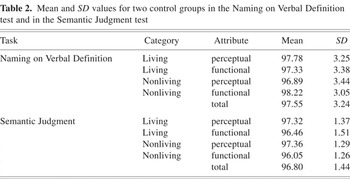
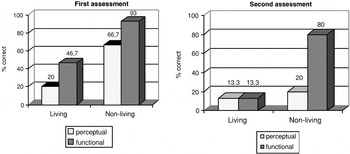
VZ's performance (percentage of correct answers) in the Naming on Verbal Definition task.
A year later, VZ correctly named 4/30 (13%) living and 15/30 (50%) nonliving things, still showing a significant category difference [χ2(1) = 9.3; p < .005]. Again, she showed an attribute-type effect, naming functional definitions better (14/30, 47%) than perceptual ones (5/30, 17%), [χ2(1) = 6.24; p < .05]. This time, the effect of attribute-type was detectable only within the category of nonliving things, whereas for the category of living things performance was now severely disrupted for both types of definitions. For the naming of nonliving things, perceptual attributes were less effective (3/15, 20%) than functional definitions (12/15, 80%) [χ2(1) = 10.8; p < .001].
A comparison (see Figure 3) of the two subsequent assessments showed that VZ's performance, as time passed, greatly worsened for both categories (living: McNemar test: N = 30; p < .05; nonliving: McNemar test: N = 30; p < .005). Over time, both perceptual (McNemar test: N = 30; p < .01) and functional (McNemar test: N = 30; p < .05) knowledge also decreased for both categories. Looking at category X attribute effects over time, it can be seen that VZ's performance was very poor for both types of attributes of living things, during the first assessment, and no further decline of type of knowledge was observed for this category. In the case of nonliving things, a significant decline over time was found for perceptual knowledge (McNemar test: N = 15; p < .05), but not for functional attributes (McNemar test: N = 15; ns).
Semantic Judgment
A group of 14 participants comparable with VZ for age and education, correctly judged 185/191 items (96.8%; SD = 1.44), without significant differences between categories or attribute types (Table 2). Statistical comparison showed VZ's marked impairment in the first assessment with respect to controls [t = 15.7; p < .001, Crawford & Garthwaite, 2002]. VZ correctly judged 64% (61/95) of the statements on living things (30/48 perceptual and 31/47 functional), and 84% (81/96) of the statements on nonliving things (38/48 perceptual and 43/48 functional), thereby revealing a significant advantage for the nonliving category [χ2(1) = 10.8; p < .001], but no difference was found between the two attribute types overall [χ2(1) = .97; ns], (Figure 4, first assessment). Furthermore, although not significant, the patient judged the perceptual attributes of living things worse than those of nonliving things [χ2(1)= 3.23; p = .07], whereas she judged the functional attributes of nonliving things better than those of living things [χ2(1) = 8.49; p < .005].
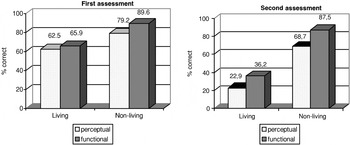
VZ's performance (percentage of correct answers) in the Semantic Judgment test.
A year later, VZ correctly judged 29% (28/95) of the statements concerning living things (11/48 perceptual; 17/47 functional), and 78% (75/96) of the statements on nonliving ones (33/48 perceptual; 42/48 functional), showing a significant advantage for nonliving things [χ2(1) = 46.3; p < .0001] (Figure 4, second assessment). Furthermore, overall VZ performed significantly worse with perceptual definitions (44/96, 46%) than with functional ones (59/95, 62%), [χ2(1) = 4.71; p < .05]. Finally, a significant loss of perceptual attributes was more marked for living than for nonliving things [χ2(1) = 20.3; p < .0001], and functional attributes were still more effective for the category of nonliving things rather than for living things [χ2(1) = 27.5; p < .0001].
The comparison of VZ's performance in the two assessments showed a greater disadvantage for living things (McNemar test: N = 95; χ2(1) = 29.3; p < .0001) than for nonliving ones (McNemar test: N = 96; ns). Over time, VZ showed a general decline in both perceptual (McNemar test: N = 48; p < .0001) and functional (McNemar test: N = 47; p < .001) knowledge of living things. However, whereas in the case of nonliving things, her perceptual knowledge in the second year had declined compared to that in the first year (McNemar test: N = 48; p = .06, one-tailed), her functional knowledge remained comparable (McNemar test: N = 48; ns).
DISCUSSION
In this study, we described a patient affected by a progressive semantic disorder, who was studied longitudinally over a period of two years. Looking at VZ's performance in all three tasks, we can discard a lexical retrieval deficit in favor of a genuine semantic disorder, which selectively affects the categories of living and nonliving things in different ways. Moreover, the differences in her performance for these two categories cannot be attributed to such potential confounds as frequency or visual complexity (Funnell & Sheridan, 1992; Stewart et al., 1992; Parkin, 1993; Parkin & Stewart, 1993).
The progression of VZ's semantic deficit shows changes in the interaction between a category-specific impairment (living vs. nonliving) and an impairment for the knowledge of features (perceptual vs. functional). In this study, robust data come mainly from the longitudinal evaluation accomplished in the first two assessments, where a category × attribute effect was observed, along with a decline that followed a clear pattern:
- 1st phase. Categorical effect: Initial knowledge loss of living things is more prominent than of nonliving things (Picture naming). Category × attribute effect: Major loss of perceptual attributes for the category of living things—an effect found only in the most demanding task for VZ (Naming on verbal definition)—whereas a trend in the same direction is found in her performance on the less difficult task (Semantic judgment).
- 2nd phase. Categorical effect: General loss of knowledge of living things, but not of nonliving things (all tasks). Category × attribute effect: Increasing loss of both perceptual and functional features concerning living things and increasing impairment of perceptual features of nonliving things (all tasks).
- 3rd phase: Although the severity of global deterioration did not allow the administration of experimental tasks, preservation of action knowledge concerning objects is indirectly observed through basic naming tasks.
Thus, while a categorical deficit is observed in both experimental sessions, the interaction between categorical and attribute knowledge appears, in the first phase of testing, only in the more demanding tasks (i.e., Naming), and not in the less demanding one (i.e., Semantic judgment). Indeed, the three experimental tasks have different requirements. All of them imply access to stored semantic knowledge, but only naming tasks also require lexical retrieval. Naming impairment was the earliest deficit in VZ's degeneration, and it was larger in the visual than in the verbal modality. The Semantic judgment task is less hard. As the disease progressed, the disorganization of VZ's knowledge made the category × attribute interaction undetectable in the tasks that are the most demanding for her, but detectable in the one that did not require name retrieval. Depending both on the degeneration stage and task requirements, category-specific effects can be observed either with or without selective attribute impairments.
Thus, in the study of dementia patients, a longitudinal perspective seems critical in highlighting the lines along which the semantic system degenerates. Quite interestingly, the patient underwent a great perceptual impairment during the first assessment, affecting mainly the knowledge of living things. This seems to support the basic predictions of Warrington and Shallice's (1984) SFT. However, SFT does not predict the widespread loss of both perceptual and functional knowledge that was found, in the second assessment, for living things. SFT, namely, only assumes a marginal involvement of the functional features if there is a selective deficit of living things. Therefore, the category × attribute interaction, proposed by the SFT, cannot fully account for the present data.
VZ's pattern does not match the predictions by Caramazza and Shelton (1998) of a “pure” categorical deficit either. The authors' predictions that category-specific effects can only occur as the breakdown of a semantic domain, such as, say, animals, without the selective involvement of specific types of features is not supported by VZ's behavior. In fact, during both the first and second assessments, with some differences depending on task difficulty, the patient showed an advantage for nonliving things and for functional attributes, along with a deficit for living things and (mainly) perceptual features. VZ, therefore, shows an interaction between categories and attributes, an effect that is not hypothesized by Caramazza and Shelton's view.
That the semantic knowledge of VZ showed a clear impairment for living things right from the beginning of the study, when her general cognitive performance was still normal, is in contrast with Devlin et al.'s (1998) predictions of a primary deficit for nonliving things. For the mild-to-moderate-degeneration stages, Tyler et al. (2000) predicted that only the ability to determine the category to which living stimuli belong would be spared. This skill would be supported by intact shared-knowledge (both perceptual and functional) of living things. That VZ's answers refer to super-ordinate categories of living things in both naming tasks does indeed seem to support Tyler et al.'s (2000) predictions, but the generalized decrement of both perceptual and functional features of living things, in VZ's second assessment, does not support their model. In the case of nonliving things, Tyler and colleagues hold that distinctive functional attributes should still support discrimination in mild-to-moderate stages of the illness, via perceptual processing of shape features. However, considering VZ's performance in the two verbal tasks, it seems that perceptual information related to nonliving things allowed discrimination between exemplars of the category in the first assessment. However, in the second assessment, VZ was still able to discriminate between different members of the nonliving things category, even if perceptual knowledge of nonliving things had a consistent decline. Thus, Tyler et al.'s prediction that functional knowledge of nonliving things is helped by perceptual information is only to some extent confirmed by our data. Finally, in the most severe stages of her illness, VZ seems to rely on some kind of action knowledge that is not considered by these authors.
Keeping in mind VZ's general loss of knowledge for items of both categories, note that (1) she performs best with the help of functional features of nonliving things, and that (2) her ability to identify objects by referring to actions that can be performed with them (by producing verbs in her attempts to answer) is still intact (see also Bird et al., 2000; Bak & Hodges, 2003; Silveri et al., 2003). These two facts suggest that even in the final stages of her illness VZ might still rely on some knowledge of actions, perhaps supported by the activation of the affordance representation of objects. This interpretation is consistent with Buxbaum and Saffran (2002), who emphasize the role of “motor” knowledge (i.e., affordance) during the processing of objects. In this view, functional attributes are considered an indirect product of action/motor processing (see also Warrington & McCarthy, 1987; Tyler & Moss, 1998). The preservation of some sort of action/motor knowledge might also be consistent with the preservation of procedural learning, that is typically found in dementia (De Vreese et al., 2001).
This study suggests that category-specific deficits can indeed be interpreted in terms of a multifaceted relation between category and attribute knowledge. At least in the case of our patient, living things seem to crucially rely on perceptual processing, although there are differences due to task difficulties, as pointed out by Tyler et al. (2000). However, no theory seems to account for the generalized decline of functional knowledge of living things that we observed during our second assessment of VZ. Knowledge of nonliving things seems to be partially sustained by functional information, and partially, but for a much longer time, by some kind of action or motor knowledge. In fact, functional and motor knowledge might be intertwined in the representations of nonliving things (Buxbaum & Saffran, 2002), which could be an interesting aspect to disentangle in future studies.
Finally, it seems crucial to track category-specific deficits in patients with degenerative processes, by taking task requirements and severity of damage into account at several stages of these processes. The adoption of such an approach for degenerative investigations may thus reveal complex effects that could either be misinterpreted or underestimated in single-assessment studies.
APPENDIX 1. Examples from the Naming on Verbal Definition task

APPENDIX 2. Examples from the Semantic Judgment test
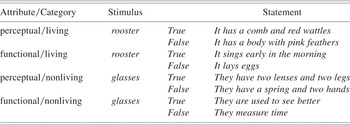
References
REFERENCES

MRI scan of patient VZ, showing severe atrophy involving the right superior, middle and infero-medial temporal gyri, and the right perisylvian regions.

VZ's general neuropsychological examination during the first and the second assessments

VZ's performance in the Picture Naming test (percentage of correct answers).

Mean and SD values for two control groups in the Naming on Verbal Definition test and in the Semantic Judgment test

VZ's performance (percentage of correct answers) in the Naming on Verbal Definition task.

VZ's performance (percentage of correct answers) in the Semantic Judgment test.
- 1
- Cited by




